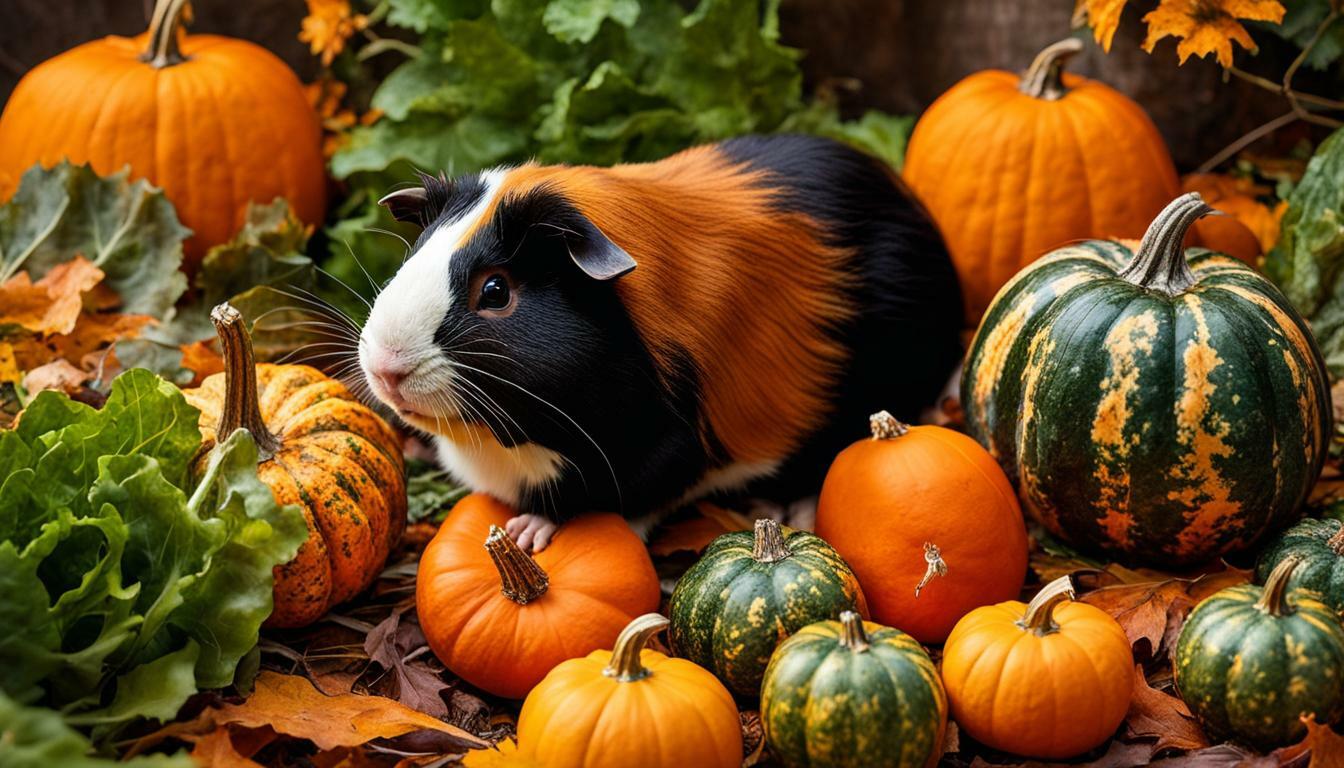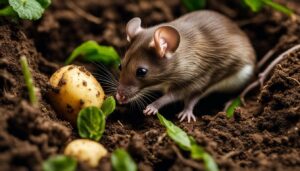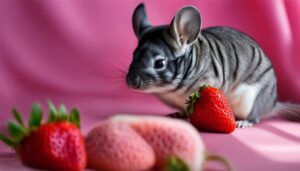Guinea pigs are adorable pets, but as a responsible owner, you may wonder if it’s safe to feed them gourds. Let’s explore the topic and find out if guinea pigs can enjoy the benefits of gourds in their diet.
Key Takeaways:
- Gourds, such as pumpkins, can be safely consumed by guinea pigs in moderation.
- Pumpkins are non-toxic and provide nutritional benefits, including beta carotene, fiber, potassium, and vitamin C.
- Avoid feeding guinea pigs pumpkin seeds, as they can pose choking hazards and dental issues.
- Feed guinea pigs raw pumpkin without any flavorings, seasonings, or cooking.
- Introduce pumpkin slowly and consult a veterinarian for personalized dietary guidance.
Understanding Gourd Consumption for Guinea Pigs
Before introducing gourds into your guinea pig’s diet, it’s essential to understand which types of gourds are safe for their consumption. Guinea pigs can eat certain gourds, such as pumpkins, in moderation. Pumpkins are non-toxic and safe for guinea pigs to consume. They provide several nutritional benefits that contribute to their overall health and well-being.
Pumpkins are rich in beta carotene, a compound that is converted into vitamin A in the body. This vitamin is essential for maintaining good eye health and promoting proper skin hydration in guinea pigs. In addition to beta carotene, pumpkins also contain fiber, which aids in digestion and helps prevent constipation. They are a good source of potassium, which plays a crucial role in regulating fluids and maintaining a healthy heart.
Furthermore, pumpkins are a natural source of vitamin C, an important nutrient for guinea pigs. Vitamin C is vital for their immune system function and helps prevent illnesses. However, it’s important to note that guinea pigs should not consume the seeds of pumpkins. The seeds can present a choking hazard or get stuck in their teeth or throat. Additionally, the flesh of pumpkins is relatively high in sugar, so it should be given in small amounts to avoid tooth decay, constipation, and obesity.
| Gourd Type | Safety |
|---|---|
| Pumpkins | Safe for consumption; provide nutritional benefits |
| Pumpkin Seeds | Avoid feeding; potential choking hazard and dental issues |
| Pumpkin Leaves | Occasional and moderate consumption; high in calcium |
When introducing gourds into your guinea pig’s diet, it’s important to do so gradually. Start with small amounts and monitor their digestive health for any adverse reactions. It’s always best to consult a veterinarian for proper dosage and personalized dietary guidance, especially when it comes to incorporating gourds into your guinea pig’s diet and ensuring they receive adequate vitamin C.
Nutritional Benefits of Gourds for Guinea Pigs
Pumpkins, a type of gourd, can provide several essential nutrients that are beneficial for the overall health of guinea pigs. These vibrant orange vegetables are packed with beta carotene, a precursor to vitamin A, which plays a crucial role in maintaining healthy eyesight and promoting hydrated skin. Including pumpkins in your guinea pig’s diet can help support their visual acuity and keep their skin supple and moisturized.
In addition to beta carotene, pumpkins are a great source of fiber, potassium, and vitamin C. Fiber aids in maintaining a healthy digestive system by promoting regular bowel movements and preventing constipation. Potassium, an electrolyte, helps regulate fluid balance in the body, ensuring proper hydration and supporting overall organ function. Meanwhile, vitamin C is essential for guinea pigs as it boosts their immune system and protects against illness and disease.
However, it’s important to note that while pumpkins offer numerous health benefits, certain precautions should be taken when including them in your guinea pig’s diet. The seeds of pumpkins should be avoided as they can pose a choking hazard and may lead to dental issues. Additionally, the flesh of pumpkins contains natural sugars, so it should be given in small amounts to prevent tooth decay, obesity, and digestive problems.
| Nutrient | Function |
|---|---|
| Beta Carotene | Supports eye health and skin hydration |
| Fiber | Promotes digestive health and prevents constipation |
| Potassium | Regulates fluid balance and supports organ function |
| Vitamin C | Boosts immune system and protects against illness |
When feeding your guinea pig pumpkins, it’s crucial to use raw pumpkin without any flavorings, seasonings, or cooking. Introduce pumpkins slowly into their diet to allow their digestive system to adjust, and always consult with a veterinarian regarding their specific dietary needs. Additionally, while the leaves of the pumpkin plant can be fed to guinea pigs occasionally, they are high in calcium, so be sure to balance their intake with other calcium sources to prevent imbalances in their diet.
Remember, maintaining a healthy and balanced diet is key to ensuring the well-being of your guinea pig. By incorporating pumpkins in moderation and following proper guidelines, you can provide your furry friend with a nutritious and enjoyable addition to their mealtime.
Moderation and Safety Considerations
While gourds can be a nutritious addition to a guinea pig’s diet, it’s crucial to exercise caution and prioritize moderation to ensure their well-being. When it comes to feeding gourds, particularly pumpkins, to your furry friend, there are a few safety considerations to keep in mind.
Avoid Pumpkin Seeds and Flavored Gourds
Firstly, it’s important to note that guinea pigs should not consume pumpkin seeds. These seeds can pose a choking hazard and may lead to dental issues. Therefore, it’s best to remove them before offering any part of the pumpkin to your guinea pig.
Additionally, flavored or seasoned gourds should also be avoided. Guinea pigs should only be fed raw, unseasoned pumpkin without any added flavors. Flavored gourds may contain ingredients that are harmful to guinea pigs or cause an upset stomach. It’s always safest to stick to plain, fresh gourds.
Control Portion Sizes and Monitor Overall Health
Since the flesh of pumpkins contains a relatively high amount of sugar, it’s crucial to control portion sizes. Too much sugar can lead to tooth decay, constipation, and even obesity in guinea pigs. It’s recommended to introduce pumpkin gradually and in small amounts, monitoring your guinea pig’s health closely. If you notice any signs of digestive issues or weight gain, it’s advisable to reduce or discontinue pumpkin consumption.
As with any dietary change, it’s essential to consult a veterinarian before incorporating gourds into your guinea pig’s diet. Every guinea pig is unique, and a vet can provide personalized guidance on the appropriate portion sizes and overall vitamin C intake for your furry companion. They can also address any specific concerns or risks that may be relevant to your guinea pig’s health.
| Gourd Safety Tips |
|---|
| Avoid feeding pumpkin seeds |
| Offer only raw, unseasoned gourds |
| Control portion sizes to prevent tooth decay, constipation, and obesity |
| Consult a veterinarian for personalized guidance |
Pumpkin Seeds and Guinea Pigs
Although guinea pigs can eat certain parts of a gourd, it’s important to exclude pumpkin seeds from their diet to prevent potential health risks. While the flesh of pumpkins offers various nutritional benefits for guinea pigs, the seeds can pose a choking hazard and may cause dental issues. Therefore, it is crucial to remove the seeds before offering pumpkin to your furry friend.
Pumpkin seeds are small and hard, which can make them difficult for guinea pigs to chew and swallow. If ingested, they may become lodged in their teeth or throat, causing discomfort and potentially leading to more serious health complications. It is essential to ensure that your guinea pig’s diet does not include pumpkin seeds to keep them safe and healthy.
If you want to provide your guinea pig with a similar crunchy texture, there are alternative treats specifically made for guinea pigs available in pet stores. These treats are formulated to be safe and appropriate for their dietary needs, allowing them to enjoy a satisfying crunch without the potential risks associated with pumpkin seeds.
| Dietary Considerations for Guinea Pigs |
|---|
| ✔️ Offer guinea pigs a variety of fresh vegetables and hay for a well-rounded diet |
| ✔️ Avoid giving guinea pigs foods that are high in sugar, salt, or seasoning |
| ✔️ Provide clean, fresh water at all times to keep guinea pigs hydrated |
| ✔️ Consult a veterinarian for personalized dietary recommendations |
Remember, the well-being and health of your guinea pig should always be a top priority. By excluding pumpkin seeds from their diet and offering them a balanced and appropriate food selection, you can ensure that your furry companion remains happy and healthy for years to come.
Introducing Gourds to Your Guinea Pig’s Diet
When incorporating gourds into your guinea pig’s diet, it’s essential to introduce them gradually and observe any reactions or changes in their well-being. Guinea pigs can enjoy eating certain types of gourds, such as pumpkins, in moderation. Pumpkins are safe and non-toxic for guinea pigs to consume. They offer several nutritional benefits that contribute to their overall health.
Pumpkins are rich in beta carotene, which is beneficial for your guinea pig’s eye health and skin hydration. They also contain fiber, potassium, and vitamin C, which support proper digestion, fluid regulation, and a healthy immune system. However, it’s important to note that guinea pigs should not consume pumpkin seeds, as they can pose a choking hazard or get stuck in their teeth or throat.
When feeding gourds to your guinea pig, it’s crucial to provide them with raw pumpkin without any flavorings, seasonings, or cooking. The flesh of pumpkins is relatively high in sugar, so it should be given in small amounts to avoid dental issues, constipation, or obesity. Additionally, the leaves of the pumpkin plant can be offered to guinea pigs infrequently and in moderation, as they are high in calcium. Always consult with a veterinarian regarding your guinea pig’s specific dietary needs and vitamin C intake.
| Gourd Varieties | Description |
|---|---|
| Butternut squash | A sweet and nutty gourd that can provide variety to your guinea pig’s diet. |
| Acorn squash | A mild and slightly sweet gourd that can be enjoyed by guinea pigs. Remove the seeds and skin before offering. |
| Spaghetti squash | A unique gourd with stringy flesh that provides a fun texture for your guinea pig to explore. |
| Kabocha squash | A sweet and flavorful gourd that can be a nutritious addition to your guinea pig’s diet. |
In conclusion, gourds such as pumpkins can be included in your guinea pig’s diet in moderation. These gourds offer nutritional benefits but should be introduced gradually and without seeds or added seasonings. Always monitor your guinea pig’s well-being when introducing new foods and consult with a veterinarian for personalized dietary advice.
Pumpkin Leaves for Guinea Pigs
While gourds can be a part of a guinea pig’s diet, pumpkin leaves should be offered occasionally and in moderation due to their calcium content. Guinea pigs require a balanced intake of calcium to support their bone health, but excessive amounts can lead to urinary problems. Pumpkin leaves are high in calcium, so it’s important to offer them sparingly to prevent calcium imbalances.
When introducing pumpkin leaves to your guinea pig, ensure they are fresh and thoroughly washed to remove any dirt or pesticides. It’s advisable to start with small portions and observe your guinea pig’s response. If they tolerate and enjoy the leaves, you can gradually increase the serving size, taking care not to exceed recommended calcium levels. Always consult with a veterinarian to determine the appropriate amount of calcium for your guinea pig’s individual needs.
| Benefits of Pumpkin Leaves for Guinea Pigs |
|---|
| Pumpkin leaves are a source of calcium, which is essential for bone health in guinea pigs. |
| They provide variety in a guinea pig’s diet, offering a different texture and taste compared to other leafy greens. |
| Small amounts of pumpkin leaves can contribute to a well-rounded nutritional intake for your guinea pig. |
Remember, while pumpkin leaves can be beneficial, they should not be the primary source of leafy greens in your guinea pig’s diet. It’s important to offer a variety of fresh vegetables and leafy greens to ensure your guinea pig receives a wide range of nutrients. Consult with your veterinarian to develop a balanced diet plan that meets your guinea pig’s individual needs.
Vitamin C Considerations for Guinea Pigs
Guinea pigs require vitamin C in their diet, and gourds like pumpkins can help fulfill this nutritional need. Pumpkins are not only safe for guinea pigs to consume, but they also provide several health benefits. They are rich in beta carotene, a pigment that converts to vitamin A in the body and promotes healthy eyesight and skin hydration.
In addition to beta carotene, pumpkins contain fiber, potassium, and vitamin C. Fiber plays a crucial role in maintaining healthy digestion for guinea pigs, preventing issues such as constipation and promoting regular bowel movements. Potassium is important for regulating fluids and maintaining a healthy balance in the body, while vitamin C is essential for boosting the immune system and supporting overall health.
It is important to note that guinea pigs should not consume pumpkin seeds as they can pose a choking hazard and cause dental issues. The flesh of pumpkins, although beneficial, should be given in moderation due to its relatively high sugar content. Feeding guinea pigs raw pumpkin without any flavorings, seasonings, or cooking is recommended to ensure they receive the full nutritional benefits.
Pumpkin leaves, on the other hand, can be offered to guinea pigs occasionally and in moderation. These leaves are high in calcium, which is important for their bone health. However, it is crucial to balance the calcium intake with the overall diet to avoid any imbalances or potential health issues.
| Vitamin C Considerations for Guinea Pigs |
|---|
| Guinea pigs require vitamin C in their diet. |
| Gourds like pumpkins can help fulfill this nutritional need. |
| Pumpkins are safe for guinea pigs to consume. |
| Pumpkins are high in beta carotene, fiber, potassium, and vitamin C. |
| Guinea pigs should not eat pumpkin seeds. |
| Pumpkin flesh should be given in moderation due to its sugar content. |
| Pumpkin leaves can be offered occasionally and in moderation. |
| Consult a veterinarian for personalized dietary guidance. |
In conclusion, gourds like pumpkins can be a beneficial addition to a guinea pig’s diet, especially when considering their vitamin C requirements. However, it is essential to feed pumpkins in moderation, avoid the seeds, and consult a veterinarian for personalized guidance on proper nutrition and portion sizes for your guinea pig.
Consultation with a Veterinarian
To ensure the optimal health and well-being of your guinea pig, it is always recommended to consult a veterinarian regarding their diet, including the introduction of gourds. Guinea pigs have specific dietary needs that may vary based on factors such as age, weight, and overall health. By seeking professional advice, you can ensure that you are providing your furry friend with a well-balanced and appropriate diet that includes gourds in a safe and controlled manner.
A veterinarian will be able to assess your guinea pig’s individual nutritional requirements and advise you on the specific types and quantities of gourds that are suitable for them. They can guide you in gradually incorporating gourd varieties, such as pumpkins, into your guinea pig’s diet, taking into account any existing health conditions or dietary restrictions.
In addition to providing guidance on gourd consumption, a veterinarian can also provide information about other important aspects of your guinea pig’s diet, such as hay, fresh vegetables, and water requirements. They can help you create a well-rounded meal plan that meets all of your guinea pig’s nutritional needs, including the necessary intake of vitamin C, which is vital for their overall health and immune system.
Consulting a veterinarian is especially crucial if your guinea pig:
- Has a history of health issues
- Is pregnant or nursing
- Is a young guinea pig
- Exhibits any unusual eating habits or symptoms
Your veterinarian will be able to provide personalized advice based on your guinea pig’s specific circumstances, ensuring that they receive the appropriate gourd varieties and quantities without compromising their health. Remember, while gourds can be a nutritious addition to your guinea pig’s diet, moderation is key, and professional guidance is essential for their overall well-being.
Conclusion
In conclusion, guinea pigs can safely eat certain gourds, such as pumpkins, in moderation, but it is crucial to prioritize their overall well-being and consult a veterinarian for expert advice on their specific dietary requirements.
Pumpkins are non-toxic and safe for guinea pigs to consume. They offer various nutritional benefits, including high levels of beta carotene, which promote eye health and skin hydration. Pumpkins also contain fiber, potassium, and vitamin C, which support digestive health, regulate fluids, and boost the immune system.
However, it is important to note that guinea pigs should not eat the seeds of pumpkins. The seeds can potentially get stuck in their teeth or throat, causing choking hazards and dental issues. Additionally, the flesh of pumpkins is relatively high in sugar, so it should be given in small amounts to avoid tooth decay, constipation, and obesity.
When introducing pumpkins to a guinea pig’s diet, it is recommended to start gradually and monitor their digestive health. It is crucial to feed guinea pigs raw pumpkin without any flavorings, seasonings, or cooking. The leaves of the pumpkin plant can also be fed occasionally and in moderation, as they are high in calcium. However, always consult a veterinarian for guidance on the appropriate amount of vitamin C intake for your guinea pig.
By ensuring a balanced and informed approach to their diet, you can provide your guinea pig with a safe and enjoyable experience while incorporating gourds like pumpkins into their meals. Remember, every guinea pig is unique, so consulting a veterinarian is essential to tailor their dietary needs and promote their overall health and happiness.
FAQ
Can guinea pigs eat gourds?
Yes, guinea pigs can eat gourds such as pumpkins in moderation.
Are pumpkins safe for guinea pigs?
Yes, pumpkins are non-toxic and safe for guinea pigs to consume.
What are the nutritional benefits of pumpkins for guinea pigs?
Pumpkins are high in beta carotene, fiber, potassium, and vitamin C, which support eye health, skin hydration, digestive health, fluid regulation, and boost the immune system in guinea pigs.
Can guinea pigs eat pumpkin seeds?
No, guinea pigs should not eat pumpkin seeds as they can get stuck in their teeth or throat.
How should pumpkins be prepared for guinea pigs?
Guinea pigs should be fed raw pumpkin without any flavorings, seasonings, or cooking.
Can guinea pigs eat pumpkin leaves?
Guinea pigs can eat pumpkin leaves infrequently and in moderation, as they are high in calcium.
Why is moderation important when feeding gourds to guinea pigs?
Moderation is important to avoid tooth decay, constipation, and obesity in guinea pigs due to the relatively high sugar content of pumpkin flesh.
How should gourds be introduced to a guinea pig’s diet?
Gourds, particularly pumpkins, should be introduced gradually to a guinea pig’s diet, and any changes in their digestive health should be monitored.
Is vitamin C important for guinea pigs?
Yes, vitamin C is important for guinea pigs, and gourds can contribute to meeting their vitamin C requirement.
Should I consult a veterinarian before feeding gourds to my guinea pig?
Yes, it is recommended to consult a veterinarian for proper dosage and personalized dietary advice for your guinea pig.




